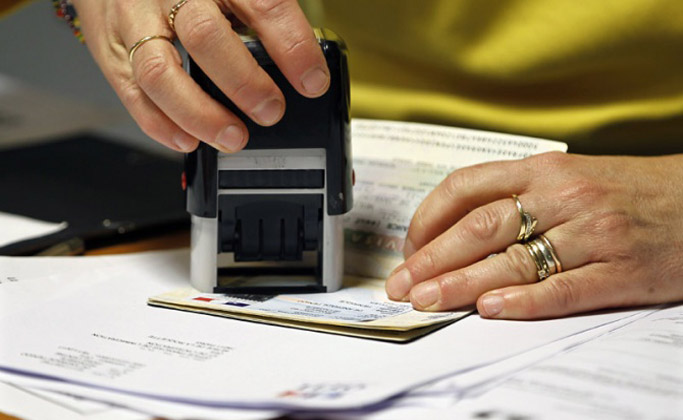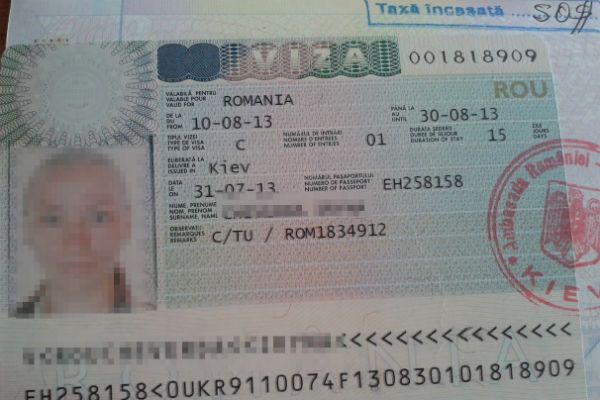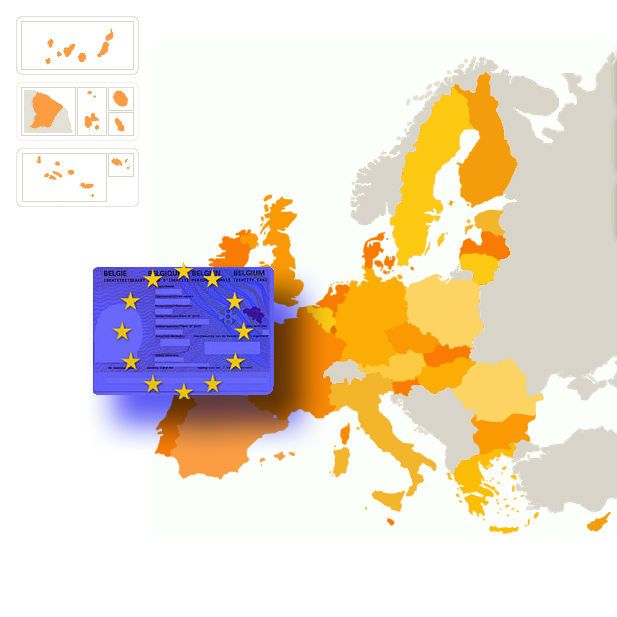29.03.2014
How to get a multiple visa for a year?
If your life is inextricably linked with foreign trips, then it would be most reasonable to take care of obtaining a multiple permit. Everyone knows that as a result of the “birth” of the landmark Schengen agreement, almost all European powers united into a single space in order to simplify the process of moving their citizens across the continent. But residents of non-EU countries require an appropriate permit for this - a Schengen visa.
Based on the number of entry permits, tourist visas (type C) are divided into single-entry and multiple-entry visas (multivisas).
Theoretically, every applicant can request a multiple visa (this right is given to everyone) for any period of up to 5 years. But such long periods of validity of permits are rather an exception to the rule. One of the most common options is a Schengen multiple visa for a year.
Despite the fact that the Schengen annual multiple visa is not the most long-term permit, you can get it without good reason if you independent registration very, very difficult.
What is a Schengen multiple entry visa for a year?
A multiple visa (Schengen) for a year is a colorful sticker in the passport, which during the specified period gives the right to visit Europe an unlimited number of times. In other words, you can get a multiple visa for a year at the embassy or consulate of one country, but then travel with this document to other Schengen states.
But there is a firm rule: the state that issued the multiple permit must be first on the list of visits, or you need to spend more time on its territory than in other European countries. You can get around this rule, but if you are caught doing this (and this happens quite often), next time a multiple visa (Schengen) for 1 year will not be opened for you. It is quite possible that you will be denied even a single permit.
A Schengen multiple visa for 1 year (type C) is a tourist visa, therefore it does not give its holder the right to work and receive education abroad.
Validity of a one-year Schengen visa
As the name implies, the annual multiple Schengen visa is valid for a calendar year. But for any violations, the tourist can be expelled from the territory of the European Union, and his visa can be revoked. Sometimes the initiator of termination of the visa corridor is the applicant himself (due to personal circumstances).
But if the visa corridor is open for a year, this does not mean that you can stay in the European Union for this entire period. You are still obliged to travel to your homeland. As a rule, an annual Schengen visa is marked with numbers separated by a fraction: 180/360. This means that you have the right to stay abroad for 3 months during each half-year. Moreover, according to the new rules, this period is calculated for the calendar period, and not for the given visa half-year. This made life somewhat more difficult for all Russian tourists.
How to get an annual multiple entry visa?
In principle, the process of independently opening an annual multiple visa is no different from issuing a single-entry permit: all the steps are the same. Perhaps the requirements for the applicant’s personality are even more stringent, and to open a multiple visa, much more compelling reasons are needed.
Accordingly, tourists from Russia receive refusals to issue a multiple-entry visa much more often.
But clients of the visa agency Visa4you need not worry: they will receive their annual multiple visas in Schengen zone under any circumstances!
A multiple visa is a special visa that gives you the right to enter the country that issued this document several times. In Russia, as a rule, this multiple visa applies to the Schengen countries.
Today, there are several types of visas for entry into the territory of the Schengen countries: single-entry, double-entry and multiple-entry visas. Any resident of our country can choose the option that is convenient for him.
Single entry visa allows you to visit the country once during a designated period. Let's say you decide to go to the Czech Republic from 09.12.2014 to 09.22.2014 and get a visa for given time. This means that you must enter the country no earlier than September 12, 2014 and leave no later than September 22, 2014. This is carefully monitored by the consulate of the receiving party. In many countries (for example: Lithuania, Latvia, Estonia), a violation of the regime will include a situation in which you issued a visa for fifteen days, but stayed in the country for only ten. Therefore, before traveling, you need to carefully read the visa regulations of each country so that in the future there will be no problems when obtaining a visa again.
Double entry visa gives you the opportunity to visit the country that issued your visa twice within the specified period of time. In this case, you must also carefully study the requirements of the consulate of the country you have chosen for travel. In the requirements you may find a clause that specifies the required interval between entries. For example, you were issued a six-month visa, with a specified interval between visits to the country - at least 40 days. If you re-enter the country before the specified period, this will be considered a very serious violation of the visa regime.
Multiple or multiple entry visa a Schengen visa is given for a certain period (from 6 months to 5 years) and allows you to enter the territory of the countries participating in the agreement a certain number of times (the exact number is fixed in the visa), on the second and subsequent visits regardless offirst entry rules .
Advantages of a multiple visa
Firstly, it gives the right to an unlimited number of entries into the territory of the selected country. Since it is issued for enough long term(from six months to five years), this type The visa is suitable for those who make frequent trips abroad for work purposes and simply love to travel.
It is important to remember that the period for which the visa is issued may differ from the permitted time in the country. A mark in your passport will help you with this.
Let's say you received a Schengen multiple entry visa from the Italian consulate marked "180/90". These numbers mean that you can enter the country an unlimited number of times within six months, but with the right to stay in the territory of the Schengen countries for no more than 90 days. In this case, we repeat, you do not have to worry about the rule of first entry. It applies to single and double entry visas.
An important advantage of the Schengen multiple visa is that its recipient has the opportunity to visit countries that are members of the Schengen agreement an unlimited number of times in one trip, of course, within a given period of time. This is an ideal option for traveling by car in Europe, when in a few days you can visit several countries at once without worrying about problems with documents. Avid travelers know that the most generous countries for Schengen visas are Italy, Finland and Spain.
How to get a Schengen multiple entry visa?
In terms of issuing visas, it is the most loyal to Russian citizens a country. Even those who have not yet entered France itself, but have been to any of the agreement countries in the last 2 years, can count on being issued a multiple-entry visa. Try to make your first trip on a multivisa issued by this country exactly according to the dates and route stated when submitting your application - next time this will increase your chances of receiving an even longer-term visa.
Spain began issuing long-term visas quite recently, but it often issues six-month visas even to those who have never been to the country. It will not be superfluous to indicate in the application any fact that will confirm your need for this particular type of visa. A similar fact could be, for example, the case when you live in a city where there is no visa center the country you need.
Slovakia began issuing two-year multiple visas also recently - in 2012. The official website of Slovakia does not answer the question of what travel parameters to indicate so that you can definitely get a multiple visa for 2 and 5 years. The likelihood that you will be given single entry visa, increase if you have already been to other agreement countries during the last six months.
Italy quite often issues annual multiple visas. At the same time, the chances of getting such a visa increase with each of your trips to Italy. 2 stamps in 2 years - and the annual visa is almost one hundred percent yours.
Greece
Another country that is favorable to multi-visa applicants. Here you need to act in stages - the first time you apply, you will most likely be given a “cartoon” for 180 days, the second time, if you indicate this in the application form, they will give you a “cartoon” for 365 days.
Finland is known to love tourists from the North-Eastern Federal District. St. Petersburg visa centers often issue first visas for 30 days, and upon repeated application - immediately for a year. Moscow visa centers are not so generous, but they are quite loyal to tourists who have an entry stamp to Finland in their passports.
Of course, there are not only Schengen multiple visas. You can obtain a document giving the right to visit the country multiple times over a certain period of time at the consulate of any visa country. You can apply for this, like any other type of visa, through a travel agency or by contacting the consulate of the country you want to visit.
All you have to do is book your flight tickets low cost airlines(low cost), pack your bags and go!
At the same time, you do not need to collect a lot of documents to obtain the next Schengen visa, or stand in tiresome queues at the visa center every time you want to take a break from everyday work abroad.
And all this is real if in your foreign passport Schengen multiple visa has been stamped!
The Schengen multiple visa is one of the most common and popular types of Schengen visa, which allows its holder to enter the territory of the Schengen zone states an unlimited number of times during the entire period of its validity. In fact, a multiple visa is actually the same Schengen visa, but multiple entries.
Main types of Schengen multiple entry visa
Depending on the purpose of visiting a Schengen country, multiple visas are of the following types:
| Tourist visa | student visa(equal to a residence permit) | |
| Business visa | Work Visa(also equivalent to a residence permit) | |
| Visitor visa | ||
It is worth remembering that each type of Schengen multiple visa has its own clear conditions and individual application rules that must be followed in order to guarantee a positive result. Considering the fact that this article is about tourist travel, we will consider, using an example, all the nuances of obtaining a tourist Schengen multiple visa.
Additional documents to confirm multiple entry
Regardless of the purpose of your trip, a Schengen visa can be multiple-entry if you confirm the need for multiple entries. You do not need to collect any additional documents to confirm multiple entry.
The Consulate of the country you are requesting may ask why you need a multiple visa. But, of course, they may not ask. It all depends on the mood of the visa center officer.
Validity period of the Schengen multiple visa
Schengen multiple visas are issued for a period of validity from one month to 5 years. This period is called the visa corridor and is the period within which the visa holder can both enter and exit the territory of the Schengen states.
However, according to current rules According to the Schengen Agreement, holders of multiple visas are prohibited from arriving in the Schengen area throughout the entire visa corridor.
Holders of Schengen visas are allowed to stay in the Schengen area for no more than half the validity period of the visa, while for multiple visas a period of no more than 90 days within six months is provided. The half-year countdown begins from the moment the borders of the Schengen zone are actually crossed.
Rules for obtaining a tourist Schengen multiple visa
If you are planning a trip throughout Europe (not taking into account the UK - it is not part of the Schengen zone), then to apply for a Schengen multiple visa you should contact the Consulate of the country in whose territory you are going to stay the longest - the rules of the Schengen agreement.
If you plan to spend the same number of days in each country of residence, then submit documents to the Consulate of any of them (for citizens of Ukraine, the most loyal Consulate of Poland).
It should also be remembered that the first entry into the territory of the agreement with a Schengen multiple entry visa must be made through the state in whose Consulate the visa was issued. This mandatory requirement all countries of the Schengen area. You can return to your homeland through the borders of any Schengen country, and all subsequent entries into the agreement zone can be carried out through any state.
Documents for obtaining a tourist Schengen multiple visa
Do not forget about the main rule of obtaining a Schengen multiple visa: when preparing and processing documents, be guided solely by your own mind! Also carefully study the information on the official website of the Consulate of the country in which you are going to obtain a visa. You should not use the services of intermediaries who gather in crowds at the Embassies.
Visa fee at the French Consulate in Ukraine
| Consular fee | Sum |
| For citizens of Ukraine | 35 euros |
| For Russian citizens | 35 euros |
| For citizens of Moldova | 35 euros |
| For citizens of Georgia | 35 euros |
| For citizens of other countries | 60 euros |
| Persons exempt from paying visa fees | |
1). Visa application form from the French Consulate in Ukraine
The application form for a Schengen visa must be completed in two copies and signed personally by the applicant (if the applicant has not reached the age of majority, then one of the parents/guardian must sign the visa application on behalf of the child);
2. Two passport size photographs
3. Valid passport
A foreign passport valid for at least 3 months from the date of return;
Photocopies of all pages of the international passport, which are submitted along with the application form;
4. Medical insurance policy
A prerequisite for obtaining a Schengen multiple visa is that the applicant has a medical insurance policy valid in all Schengen countries with a minimum coverage of 30 thousand euros.

5. Documents confirming solvency
Certificate from place of work indicating the amount of wages for the last six months, or a certificate from the place of study, or a certificate of company registration;
Documented information about additional sources of income (rental income, availability of real estate, shares, etc.);
Applicants who do not have their own income must provide documents confirming the solvency of the sponsors on whom they depend;
Photocopies of previous Schengen visas, if issued;
6. Confirmation of residence availability
The Embassy requires applicants to provide an invitation from a tour operator (in case of a tourist visa) or confirmation hotel reservations(in other cases);
7. Confirmation of provision of a vehicle
It is necessary to provide the Consulate with copies of the counterfoils air ticket bookings in case of traveling by plane. If you are planning a trip on your own vehicle, then you should prepare car insurance, registration certificate and driver's license (all copies).
Special cases when applying for a Schengen multiple visa
Citizens of other countries must provide a photocopy of their residence permit and work permit, but at the time of submitting copies of documents to the Consulate, they must present the original;
For persons under the age of majority who are traveling abroad unaccompanied by adults, it is necessary to prepare a notarized permission from the parents, which clearly indicates the dates of the child’s trip, plus attach a copy of the child’s birth certificate, a photocopy of the parents’ passports (national and foreign) and a certificate from the place of residence parents' work.
Setting a date and time for submitting documents to the visa center
To apply for a Schengen multiple visa, you must register in advance. You can do this in two ways:
Sign up online on the website of the visa center of the Consulate of interest;
Call the call center of the visa center of the country you are requesting.
You will not be able to submit documents to the Consulate without authorization, since a preliminary registration is provided, in accordance with which documents are directly accepted. Your documents will be accepted only after an official invitation from the Embassy. When submitting your documents, the visa center employee will hand you a check with the visa fee. It must be paid at the Consulate cash desk in national currency.
If the Consulate asks you why you need a Schengen multiple visa, answer simply: because I travel often! True, the first time a multiple visa may be issued not for a year, but for six months.
Of course, no one will ever give you a 100% guarantee of a visa. Risk of getting refusal to issue a Schengen visa everyone always has it. But subject to compliance with all the above rules for obtaining a Schengen multiple visa, correctly executed documents and a clearly planned route for the entire trip, this probability is reduced to a minimum.
The rules for using a multiple-entry Schengen visa were changed in 2013, but there is still some confusion based on the “old” knowledge about the rules of the Schengen visa. And this confusion often becomes a reason for refusal of the next visa.
Firstly, the concept of “main country of residence” has been introduced and border countries, for example Finland or Norway, carefully protect their territories from transit visitors who only need a visa to board a cheaper flight from Helsinki or a ferry. Therefore, if your goal is Germany, even if you fly through Finland, you should apply for a “German visa”. Of course, you can try to hide your main goal from the Finnish border guards by saying that you will stay in the country for 3-4 days and back home. And in Finland, take a plane. But, more often than not, such events are disclosed - border guards ask to see booked hotel or the phone number of the person you are staying with. There have been cases when border guards did not disdain a mini-search of things, the goal was to find plane tickets to another country.
Primary country of residence
1. The main requirement for correctly obtaining a “multi-Schengen”, multiple-entry visa type C is obtaining a visa to a specific country, which gives the right to travel to other countries. But some country must be the “main”, we say: I have a “Polish visa”, “I have a Czech visa”, etc. - this means your main country is Poland or the Czech Republic.
If you are traveling to 1 Schengen country, for example, Italy, then there are no problems with the main country, it is understandable. But most often we get Schengen for a year or 2 to travel to many countries. Then, in order not to violate the visa regime, it is important:
When obtaining a visa, determine your main country of residence. Since it is in this country that you will have to spend most of the time allotted by your visa.
If it is impossible to determine the country by the time of stay, you plan to travel around Europe, evenly distributing your time of stay across countries, and who knows which countries will attract you in a year and a half, then the main country will be the COUNTRY OF YOUR FIRST ENTRY. However, when choosing such a criterion, you should be careful, because you will have to follow the rule: each country has approximately the same number of days. And if you feel the urge to vacation in Spain twice, defining the country of entry as Latvia (it was your first country of entry), this will be considered a violation of the regime.
Therefore, as a rule, people choose the “main country”, assuming that it is in it that they will stay for a greater number of days, and not according to which country they will be entering for the first time.
Example:
Type: multiple entry, Schengen, tourist
Duration: one year
Country: Finland
First trip - to Spain for 10 days, Finland 2 days, then Italy (week), France (week), Germany - 15 days, and finally Finland - 3 days from Finland - Estonia (2) and Sweden (1), departure from Finland.
Whether there is a visa violations? Eat. Firstly, we spent much less time in Finland than in other European countries. Then you should have at least made your first trip to Finland... But we went to Spain.
What would need to be done?
Just in case (who knows what will happen next?) the first thing to do is go to Finland for a couple of days (more than a day), and during the validity of the visa, stay in Finland for “short” forays, at least another 15 days, and at the end of the validity of the visa , go to Finland again for a couple of days.
There are countries that do not really care about the length of stay in their country: Lithuania, Latvia, Poland. Therefore, it is believed that obtaining these visas is the easiest and most problem-free option.
The number of days allowed in the EU in general and in one country.
There are short-term and long-term Schengen visas (type C)
Long-term ones are issued for a year, 2, 3 and 5 years. Which means the visa is valid for one, two, three and five years.
However, the rule is common to all of them: you can only stay in the country (as well as in the EU zone) for 90 days in any half-year.
Example:
visa issued on March 5, 2010 for 2 years (2012). You entered the country on March 10, and from that day the countdown of your days in the EU began. It will be possible to stay in the EU zone, whether arriving or leaving, but so that the total number of days spent in the EU in six months does not exceed 90. 91 is no longer possible. Or, you can come to the country, for example, on April 5 and stay without leaving for 89 days in a row, leaving on the 90th day. With such a “maximum” consumption of days, you should be careful. If the flight is canceled, or due to some emergency circumstances you are unable to leave the country on that day, visa violations will still occur.
Until 2013, there was a very pleasant rule: “3 months within a six-month period,” which allowed you to stay in the Schengen zone for as long as six months without leaving, with the correct distribution of days.
Now, starting from October 18, 2013, when planning your trip, the length of stay must be calculated completely differently: taking into account the date planned entry into the Schengen area, calculating periods of 180 days and 90 days back from the date of planned entry. Previously, the half-year was calculated forward from the moment of the first entry into the Schengen zone in which it was possible to spend no more than 90 days.
For example, previously it was possible to do this: Visa validity period: 01/1/2010 -1/01. 2012
We entered any country for 1 day on January 1, 2010. Then we make a long trip to an EU country: we enter on April 2 and stay until June 29 (in total, all periods together are 89 days). The half-year will end on July 1st.
We enter again on June 29 and leave on July 1. On July 1st the second six month period begins and we can legally stay until September 30th. In the example we gave, a 90-day stay ends on June 29, and the next half-year begins on July 1. This way, you can make the most of your 90 days over a six-month period, combining them together for up to 180 days a year.
In a very simple retelling, the new rule sounds like this: if you have stayed in the country for 90 days in six months, Europe will take a break from you for the next 90 days.
You can look at it in more detail and thoroughly here:
How to count?
Due to the new rule, and the fact that people’s visas do not start on January 1, it can be difficult to calculate exactly the “corridor” allowed to stay in the EU. But, we have the Internet! Savvy people quickly created a lot of online calculators to calculate the days of a Schengen visa. One of them:
http://ru.visacalc.com/ or for owners of all kinds of “App” devices and phones:
http://schengen90.com/
In the date of entry/Control column, enter the date of your intended trip. In the Enter previous stays in the Schengen area section - the dates of your stay in the Schengen area, as they are indicated in your passport.
If you have a multiple-entry visa valid for a year or more. IMPORTANT NOTES:
1. The migration authorities of the EU zone ask you to leave the Schengen area one day before the end of the semester and be given the right to re-enter in the next semester.
2. Stay on long-term visas (national, stay more than 90 days) when traveling to Schengen countries NOT taken into account! How do you understand whether you have a general Schengen “Greek” visa (Greece is the main country) or a national “Greek” visa? Here is an example of a national Schengen visa. The country is written in the Valid for column.

And here is an example of a general Schengen visa: in the Valid for column it says Shengen-Valtiot, which means Schengen zone in Finnish.
how to understand. that it is “Finnish”, that is, the main country of residence is Finland, and you received this visa through the Finnish consulate? According to the language in which the information is written. Moreover, in any language one way or another the word shengen will be readable.


Articles in the Married section







 Foreign
Foreign  Residence permit in Latvia through the purchase of real estate, changes in the law.
Residence permit in Latvia through the purchase of real estate, changes in the law. The Latvian residence permit for Russians through the purchase of real estate is probably living out its last days.
The Latvian residence permit for Russians through the purchase of real estate is probably living out its last days.


